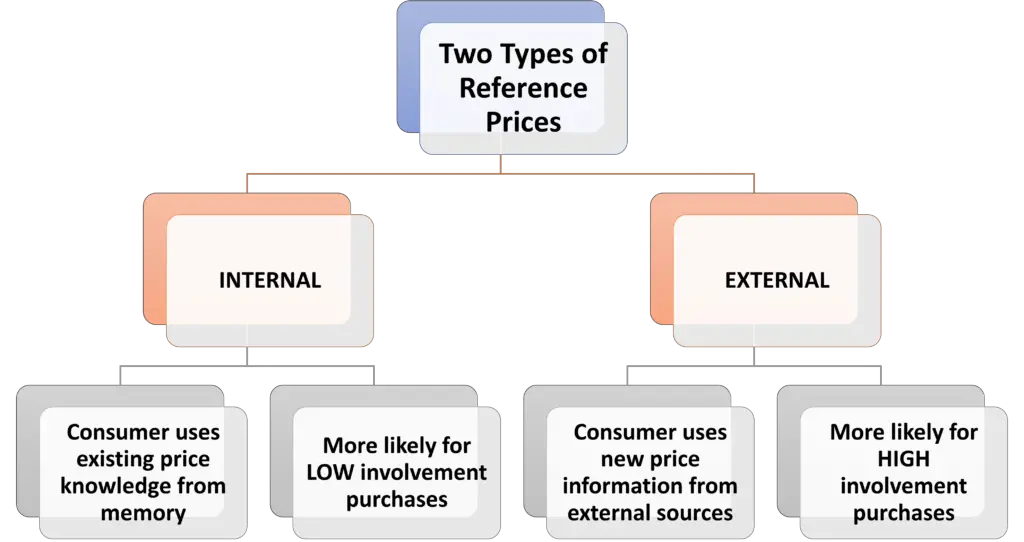Contents
What are the Two Types of Reference Prices in Marketing?
A reference price is the expected and acceptable price range that a consumer is willing to pay for a particular product and/or brand.
The word “reference” comes from the consumer referring to certain knowledge and information in order to frame the upper and lower limits of their expected price range that they are willing to pay for that product.
There are two types of reference prices that marketers need to be aware of. These are:
- Internal reference prices
- External reference prices
What is an Internal Reference Price?
When we use the term “internal” in marketing or consumer behavior, we are typically referring to the consumer’s memory and perception. In other words, the consumer relies upon internal knowledge, rather than external information.
Therefore, an internal reference price is one that is held in the consumer’s accumulated knowledge and memory.
Internal reference prices are more likely to be used for low-involvement purchases, particularly where the consumer has significant purchasing experience.
Usually, everyday products and products bought regularly through supermarkets and convenience stores would be low-involvement purchase decisions where the consumer would rely exclusively on their internal reference price information.
What is an External Reference Price?
The word “external” means that the consumer is looking beyond their existing internal knowledge for additional information.
Typically, a consumer would consider the following external sources for gathering information on the expected price range:
- in-store signage and price tags
- advertising that shows prices
- internet comparison sites
- salespeople
- friends and family
- social media and
- other marketing and non-marketing sources where prices are disclosed
A consumer is more likely to actively refer to external prices for a product category where they have limited purchasing experience and do not have a good sense of the likely price range that they should be paying.
How do internal and external reference prices impact marketing actions?
As we can see above, in both cases the consumer is using a point of reference (either internally or externally) to frame the expected and acceptable price range for a product. So why does it matter whether it is internal or external?
The reason why this is important is that internal reference prices are far more difficult for marketers to modify or manipulate. This is because internal reference prices have been constructed through multiple purchase decisions and market knowledge of the consumer.
In other words, because the consumer has bought the product category many times before, they have first-hand knowledge of the approximate price and in what price range that the product should fall.
This is the opposite to external reference prices where the marketer can influence the price point perception of a consumer.
For example, by offering a sales promotion where the discounted price is $50 and the signage indicates that the normal price is $100, then the consumer would be persuaded and influenced that $50 is a great price and represents good value.
However, this same level of influence is not possible for products where the consumer uses their internal reference price range for their decision-making.
For example, if a consumer regularly buys a can of soup for $2, then a sales promotion discount offering the same can of soup for $5 marked down from $10, this discount strategy is unlikely to be successful (and is likely to lead to dissatisfaction) as the consumer is aware that $5 is too much based upon their knowledge (their internal reference price).
In both examples above, the discount offered is 50% – but the product where the consumer is relying upon an external reference price would result in a successful sales promotion, as opposed to the purchase where they are aware of the prices and have established internal reference prices.
Connection to the Consumer Buying Decision Process
Internal and external reference price ranges are strongly connected to the buyer decision process. The consumer (or buyer) purchase decision process in most marketing textbooks will have the following structure:
- need recognition
- information search
- evaluation of alternatives
- purchase and consumption
- post purchase behavior
As you may know, the steps undertaken by the consumer will vary through the above process depending upon whether it is a high or low involvement purchase decision.
For low involvement purchases, the consumer will typically work through the buying process on an accelerated basis. And in step two, information search, they will rely upon internal information only and often make an evaluation based upon habit or heuristics (that is, simple decision-making).
However, for high-involvement purchases, the consumer undertakes a more extensive purchase decision and will rely upon external information in the information search and evaluation phases of the process.
Therefore, it is helpful to recall the variations of the buyer decision process model when considering the role of internal and external reference prices.
Related Articles

